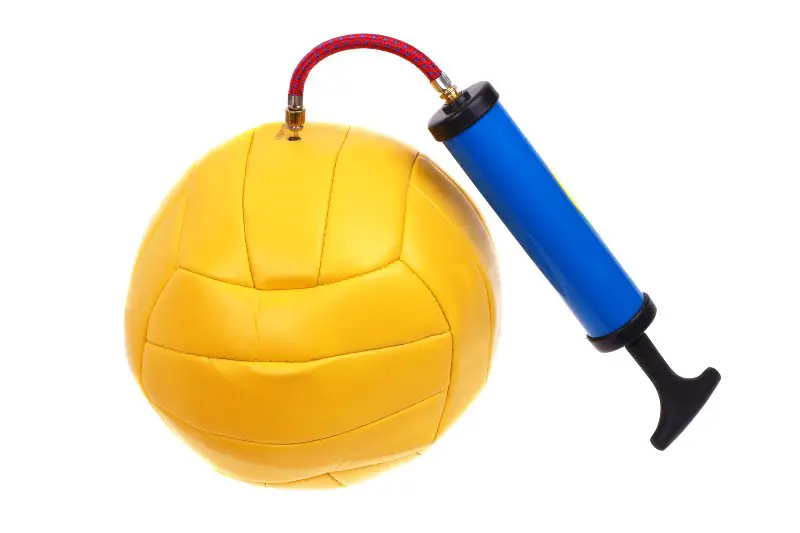
This doesn’t happen very often, but I still really hate it when I notice my volleyball keep deflating even a little bit (especially if this happens mid-match). There is nothing worse than hitting or spiking a deflated ball …
That’s why it is important to understand the reasons and causes for that. By doing so, you will prevent this from happening more often.
In this article, I address those reasons as well as how you can efficiently prevent that the ball from deflating.
Reasons why volleyballs keep deflating …
Looking at the number of times a volleyball gets punched, headed, and thrown, it’s no wonder then that a volleyball will eventually become deflated!
Volleyballs do naturally deflate overtime. As with any ball that has air inside it, the more times it gets used, it is going to lose some air each time.
Most types of volleyballs will eventually lose air over time …
Volleyballs with a butyl bladder (Just Like This One) keep the air inside the ball longer than what other balls do that have a latex bladder.
If your volleyball keeps deflating, it is likely that there is a hole in the bladder of the ball, and depending on the size of the hole will determine how quickly the ball is losing air.
One thing you can do if you think that your ball is losing air is to take it into your bathroom and fill a tub with water …
Now place the ball under the water and check for a sign of bubbles. This will indicate where the leak or hole is. Once you have found the hole/leak, you can try to patch it up and fix the leak.
Usually, most of the time, the reason why a volleyball keeps on deflating is because of a hole in the ball. The other issue could also be that there is a defect in the ball itself, in which case you can return it and get a refund.
Last reason I want to share, is the fact that that many new players are not really educated about selecting the right volleyball! That’s why, I highly recommend you learn about it.
How do you stop a volleyball from losing air?
Here are some tips on how to stop a volleyball from losing air. The ultimate focus should be about prolonging the lifespan of your ball …
Always deflate the ball when storing
During the off-season or anytime when you know you won’t be using the volleyball for a good couple of weeks, it is a great idea to leave the ball in a deflated state as this relieves the pressure and also keeps it strong for when you are actually going to use it.
You can deflate the ball by using a Pump (Like This one). You simply need the place the needle into the valve and let the ball pressure leak out.
Use the ball on suitable surfaces
Don’t be one of those people who play with a volleyball on asphalt, gravel, or concrete. This is only going to spoil your volleyball.
Stick to playing on surfaces like wood or smooth surfaces, the kinds of terrains your ball has been designed for.
Always inflate to the correct pressure
A lot of manufacturers often use fine print to indicate how much air needs to be inserted into the ball to allow for optimal ball performance.
So you need to keep an eye on the stated pressure on your volleyball!
According to the international regulations, a volleyball that is to be used in a tournament should be 65-67 centimeters in circumference and weigh 260-280 grams (9-10 oz).
The ball’s inside pressure should be 0.30-0.325 kg/cm2 (4.26-4.61 psi).
It is important to learn how to tell if volleyball has enough air!
Use a ball sealant
In case your ball has a tiny puncture, and you have successfully identified the opening by submerging it in water, you can use a ball repair sealant (Check this example here at Amazon) to fix the air leakage.
Simply spray the sealant into the ball through the valve and give it some time for even distribution of the liquid throughout the bladder. Bounce the ball a couple of times to facilitate this.
Take proper care of the valve
The needle is inserted into the valve is usually slightly sharp, and if the opening is not smooth enough to penetrate through, the outer material of the needle can also puncture the inner lining of the valve.
This is why you should always make sure that the valve opening is well lubricated with glycerin oil or silicone before you attempt to inflate the ball.
Does the ball quality limit air leaking from happening?
When purchasing volleyballs, many people tend to buy according to the price of the ball. If a ball is expensive, this means that it is a high-quality ball, and if it was a low costing ball, the ball is usually deemed to be of low quality.
While this is not always true, the fact is that the quality of the ball does make a difference in how much air leaks out.
The material that is used in making the volleyball’s cover is the biggest factor that determines how long the ball will last. Poor quality outer material can puncture quickly, thus causing the air to leak out.
At the same time, the ball’s bladder quality also makes a difference. Many balls use bladders made out of latex.
Natural latex rubber bladders offer the softest feel and response, but they do not give the best air retention.
Micro pores slowly allow the air to escape. It has been found that balls with natural rubber bladders need to be re-inflated more often than balls with butyl bladders.
Even after one or two days, the latex bladder will leak enough air so that you will have to inflate the ball back to the recommended pressure. Some balls also use carbon-latex bladders in which the carbon powder helps to close the microspores.
Volleyballs with carbon latex bladders usually increase air retention to approximately one week. Of course, you need to check the ball for punctures that may cause the air to leak out.
Volleyballs with butyl bladders offer an excellent combination of feel and air retention and can be found in most middle to upper-priced balls.
Air retention is significantly increased to weeks and months instead of days compared to balls with latex bladders.
Final Thoughts …
One last thing I want to add is when you are playing volleyball (actual game or practice). Always make sure you have a well inflated backup ball …
I mean, if all you have is one ball and it gets even slightly deflated, this will really spoil the game as the feel when hitting ball will become really uncomfortable.
Even if you have a pump or a repair sealant to fix the ball, this will interrupt your game or practice session.
Instead, by having a backup ball, you will make sure your game is not interrupted at all.
Finally, I would love that you have a look at this article on whether you can use a soccer ball as a volleyball! I think you will find it interesting …
